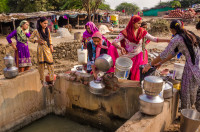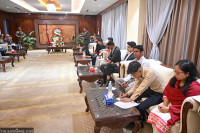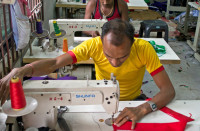Opinion
The Madhesi cauldron
Kathmandu’s power wielders have not realised that there has been a tectonic shift in the plains
Pranab Kharel & Gaurab Kc
A chapter of Nepal’s decade-long political transition ended after the promulgation of the new constitution on September 20. It also fulfilled the over six decade-old aspiration of the people to have a statute drafted by the Constituent Assembly. One of the expected outcomes of the new national charter is to ensure structural transformation by resolving the ongoing conflict. But it looks as though this will have to wait.
A section of the erstwhile political process, the Madhes-centric parties, boycotted the constitution-writing process and resorted to street protests which have already claimed over three dozen deaths. This speaks volumes about the nature of the social contract being forged between Kathmandu and the Madhes. In fact, the two sides are currently renegotiating the terms of their relationship.
The earlier movements in the Madhes were catalytic in instituting federalism in the Interim Constitution. This move had huge political and cultural ramifications. It established Madhes as an important political constituency in the Nepali landscape. It also redefined the way the Madhes was perceived of by the non-Madhesis. The interim provisions were crucial indicators of the respect and dignity earned by Madhes vis-à-vis Kathmandu. The Madhes no longer remained a subject of ridicule in Kathmandu.
So, why was there such uproar in the plains over the charter for which the Madhesis have also played a crucial role? One of the answers to this question is that the Madhesis, given the historic
changes in their relationship with Kathmandu, realised that they could
negotiate on their terms with the Capital. But for that to happen, the major political actors need to earnestly listen to the protesting voices.
Majoritarian mindset
One of the major hindrances to political progress in Nepal has been a majoritarian mindset. The belief that numerical strength alone is sufficient to push through a major political document is detrimental to fostering a real democratic culture. The rulers in Kathmandu seemed to have been intoxicated with power to the extent of bringing the Madhesis and Tharus—who otherwise share an acrimonious history—together.
The Nepali state has been brutal and repressive, dispensing privileges to a few, including the Madhesi elite. But the functionaries of the state was itself manufactured by the regional and global powers after 1990. They cultivated their vested ideologies through various structures and agencies. The members of the legislature, judiciary, bureaucracy and security became its entrenched compositions, and the major actors associated with them are their direct beneficiaries. These beneficiaries are loyal to those powers. And these beneficiaries sought to strengthen the centre at the cost of the ‘periphery’.
No longer about devolution
Rulers in Kathmandu seem to be complacent in thinking that they can accommodate the concerns of the protesters by devolving power. This is misplaced thinking. Devolution is a lexicon of the 1990s political discourse. Today, the demands of the Madhes are about being the very source of power by asserting cultural, linguistic, and political rights. In fact, the seeds of this assertion were sown back in the 1990s when there was a demand for using local languages as official languages in Rajbiraj and Kathmandu municipalities. But this was struck down by the judiciary arguing that the demand was inconsistent with the constitutional provision of the time which declared Nepali to be the only official language.
There seems to be little realisation among the wielders of power in Kathmandu that there has been a tectonic shift in the plains as it has grown to be an important player in the national politics. The parties in power belittle history by conveniently forgetting that the so-called regional parties had been formed by their very cadres in the plains who deserted them after their agenda of recognition as Nepali citizens were stifled.
Even today, a dangerous narrative is being weaved around the demarcation of federal states. The opinion makers who play an important role in shaping the agenda of Madhesi politics question why a seventh state was carved out following protests in the hills, and what prevents the same from being done in the plains.
On the issue of ignoring the past, the major players in Kathmandu do not realise that the likes of Mahanta Thakur, Rajendra Mahato and Upendra Yadav, however discredited their leadership may be, are the products of democratic procedures. To completely alienate them would compel them to stand with other Madhesi actors who advocate a more radical and violent solution to the problem—to the extent of demanding the secession of the Madhes from Nepal.
Madhes vs Madhes
While there is now an established narrative on the relationship between the Madhes and Kathmandu, very little has been discussed about the relationship among the Madhesis themselves. They also remain divided along caste, linguistic and regional lines. The caste dichotomy within Madhes is a complicated one. The tense stand-off between the forward and backward caste groups has a long history in the Madhes. Similarly, the Yadavs have also emerged as an important constituency. The regional disparity in Madhes is another indicator of division in the plains. The Eastern and Central Madhes have a grip on the political process leading to anguish among their counterparts in Western Madhes. These are certain vexing questions which the aspiring leadership of Madhes needs to address.
Kharel and KC are affiliated to the Kathmandu School of Law




 18.12°C Kathmandu
18.12°C Kathmandu










